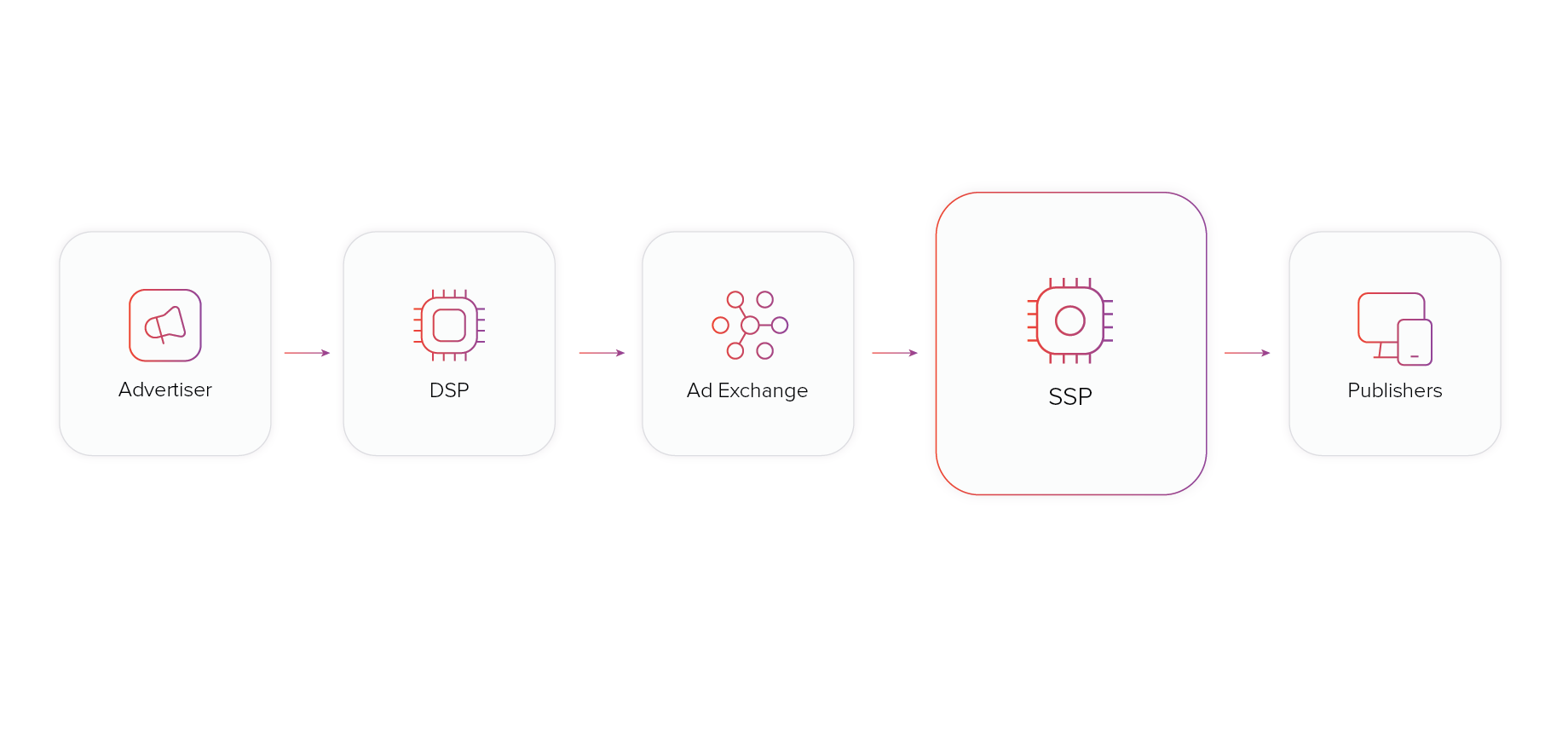Last Updated on: 26th May 2024, 08:15 pm
Programmatic advertising is the foundation of the modern marketing world. Advertisers from around the world are competing for advertising spots with bids that take under a second. This ecosystem is made up of thousands of moving pieces, and one of the most important are Supply Side Platform, or SSPs. While most readers will have heard the term, they may still ask: “What is an SSP?”
This is one of the questions which we’ll try to answer today.
In this article you will learn:
- What Supply Side Platforms do and their role in the larger programmatic advertising ecosystem.
- How Supply Side Platforms interact with publishers and help them connect with advertisers.
- How a DSP like RTB House helps you connect with SSPs.
Table of Contents:
- What is a Supply Side Platform
- How do SSPs work?
- What is the difference between an SSP and DSP?
- Why should I use an SSP?
- Why are SSPs important for publishers?
- Examples of SSPs
- How does RTB House interact with SSPs?
- Advertise on the Open Web today with RTB House
What is a Supply Side Platform
A supply-side platform (SSP) is a technology platform used by publishers to manage and sell their digital advertising inventory programmatically to advertisers and ad networks. It enables publishers to maximize revenue by offering their ad space to multiple buyers in a real-time auction rather than trying to sell them manually.  The first SSP, Pubmatic, was founded in 2006. Since then, they have become a central component of the broader programmatic advertising ecosystem. Prior to SSPs, ad buyers and sellers had to negotiate manually, but the invention of real-time bidding made it possible to automate this process, and “negotiations” are conducted by sophisticated algorithms capable of making a decision in under a second.
The first SSP, Pubmatic, was founded in 2006. Since then, they have become a central component of the broader programmatic advertising ecosystem. Prior to SSPs, ad buyers and sellers had to negotiate manually, but the invention of real-time bidding made it possible to automate this process, and “negotiations” are conducted by sophisticated algorithms capable of making a decision in under a second.
All SSPs need to interact with Demand Side Platforms in order to reach advertisers. Sometimes this is a service that the SSP offers internally, or alternatively, they simply connect with a number of external DSPs, like RTB House, in order to find advertisers.
How do SSPs work?
Not every SSP is going to offer the same functionality, but they all operate with a similar flow:
- Publisher Integration: Publishers integrate their digital properties (websites, apps, etc.) with the SSP by installing its software development kit (SDK) or integrating its code into their platforms.
- Inventory Setup: Publishers set up their advertising inventory within the SSP, specifying details such as available ad placements, ad formats, targeting options, and pricing rules.
- Ad Request: When a user visits a publisher’s digital property, the publisher’s website or app sends an ad request to the SSP, indicating details about the user, the content being viewed, and available ad slots.
- Auction Initiation: The SSP conducts an auction in real time, inviting Demand Side Platforms (DSPs), ad exchanges, and advertisers to bid on the available ad inventory. The auction process usually takes milliseconds.
- Bid Evaluation: DSPs and advertisers analyze the ad request data and submit bids based on their targeting criteria, budget constraints, and campaign goals. The SSP evaluates all incoming bids and selects the highest bidder as the winner of the auction.
- Ad Serving: Once the winning bid is determined, the SSP sends instructions to the publisher’s ad server to deliver the winning ad creative to the user’s device.
- Reporting and Optimization: SSPs provide publishers with detailed reports on ad performance, including metrics such as impressions served, clicks, revenue generated, and fill rates. Publishers can use this data to optimize their inventory, pricing strategies, and ad placements to maximize revenue.
Aside from this general flow, each specific SSP will have its own unique suite of tools and differentiators. For example, some might have a dashboard that is easier to use or more sophisticated reporting tools. Different SSPs may also specialize in different kinds of ads. Some might focus on banner ads, while others might offer adverts that more closely match the content of a specific publisher.
The ultimate goal of every SSP is to provide ways for publishers to maximize the revenue that they can generate from their websites via advertising.
What is the difference between an SSP and DSP?
Supply Side Platforms and Demand Side Platforms are two essential parts of the programmatic advertising world. Each serves the needs of specific stakeholders in order to ensure the smooth delivery of effective advertising, so what are the differences between DSPs and SSPs?
| SSP | DSP | |
| Who do they serve | SSPs facilitate the integration of various demand sources, including direct advertisers, ad networks, and DSPs, to ensure that publishers can monetize their ad inventory effectively. | DSPs are used by advertisers, agencies, and marketers to manage, optimize, and execute their ad campaigns, targeting specific audiences and maximizing the effectiveness of their advertising spend. |
| What role do they play? | SSPs help publishers maximize the revenue generated from their digital ad inventory. | DSPs allow advertisers to purchase digital advertising inventory across multiple ad exchanges and SSPs in real time. |
| What do they offer? | SSPs facilitate the integration of various demand sources, including direct advertisers, ad networks, and DSPs, to ensure that publishers can monetize their ad inventory effectively. | DSPs offer sophisticated targeting options, real-time bidding capabilities, campaign management tools, and reporting/analytics functionalities to help advertisers achieve their campaign objectives. |
Why should I use an SSP?
As a marketer you are already interacting with an SSP, most likely via your chosen DSP, as they are offering the inventory you need in order to place your ads. From a marketing perspective, SSPs simplify the process of identifying good places for your ads and offer a wider variety of ad placement options.
Additionally, SSPs mean that advertisers aren’t locked into long-term relationships with specific publishers and can instead identify the content that will be most relevant to their target audience. This ultimately improves the outcome of your marketing campaigns.
Why are SSPs important for publishers?
The real stakeholders that SSPs serve are publishers, rather than marketers. SSPs make it possible for publishers to offer ad placements to a huge variety of advertisers, represented by DSPs, and maximize the revenue that their websites generate. For example, if a specific article or video is suddenly gaining traction, an SSP would enable the publisher to maximize the revenue from traffic to that specific piece of intellectual property.
In addition to this benefit, many SSPs offer publishers features that ensure that adverts don’t degrade the overall quality of the site. For example, it is possible to set up features that will filter out ads that a publisher doesn’t agree with, such as adverts for gambling or alcohol. Most good SSPs will also filter out adverts that may contain malware, or otherwise degrade user experience on the site.
The ultimate value point for SSPs is that they keep the Open Internet open. By providing publishers with easy access to advertisers and simple ways to monetize their content, SSPs reduce the need for paywalls and other practices that limit access to important content. Without SSPs, many publishers would be forced to fence their content off, and this ultimately makes the internet a less vibrant, useful place. This also makes it possible for small publishers to compete with larger organizations.
Additionally, SSPs ensure that advertisers are able to connect with a huge range of publishers, maximizing the audience that they can reach.
Examples of SSPs
Now that we know what SSPs are, we can take a closer look at some specific examples. Every SSP is different, and each has specific characteristics that make them a good choice for publishers.
Amazon Publisher Services
Our first example is one of the biggest SSPs in the world, or rather, the biggest collection of SSPs in the world. Amazon Publisher Services (APS) brings together a wide array of SSPs in its Universal Ad Marketplace (UAP) and essentially manages the relationship between these SSPs, publishers, and DSPs.
APS is useful for publishers because of Amazon’s large market share on the demand side. One feature that stands out is access to Amazon Shopping Insights, which can help publishers determine their content strategy.
Google Ad Manager
The Google Ad Manager is probably one of the best known SSPs, and is the publisher side of the Google Ads ecosystem. It’s beneficial because of Google’s absolutely massive reach in the advertising ecosystem. It’s popular thanks to its sophisticated analytical tools, flexible bidding options, and reasonably strong brand protection tools.
One downside of Google Ad Manager is its emphasis on large organizations with strong traffic flow. It can be difficult for smaller publishers to make real money through this platform, and they may want to consider other alternatives.
Index Exchange
Speaking of smaller publishers, Index Exchange might be what they’re looking for. This platform doesn’t have the sheer muscles of Amazon or Google but offers publishers the ability to connect with a wider array of DSPs, using a no-code solution. This is useful for smaller publishers who are looking for ways to easily monetize their content.
The platform offers a wide variety of ad placement options and offers support in optimization for publishers’ inventory.
How does RTB House interact with SSPs?
Unlike Google or Amazon, RTB House doesn’t attempt to directly envelope SSPs within our own ecosystem. Instead, we collaborate with a wide variety of SSPs of all sizes in order to maximize our reach on the Open Web. This approach ensures that we have access to a diverse range of inventory and enables us to target high-value users that may otherwise be unavailable to marketers.
We also work closely with Google’s Privacy Sandbox team, which is building a toolkit for advertising on Chrome without using third-party cookies. This cooperation has given us the experience necessary to effectively reach publishers, and therefore users, using Privacy Sandbox’s APIs.
We maximize the value of this cooperation with Deep Learning algorithms. We use these in order to automatically identify the optimal placement for an advert, reducing overall campaign costs and maximizing advertiser return on investment.
Advertise on the Open Web today with RTB House
RTB House connects with a wide range of SSPs, ensuring maximum reach for your campaign. If you want to learn more about how we do this and how we can help you advertise on the Open Web, reach out to our team today, and let’s talk.





